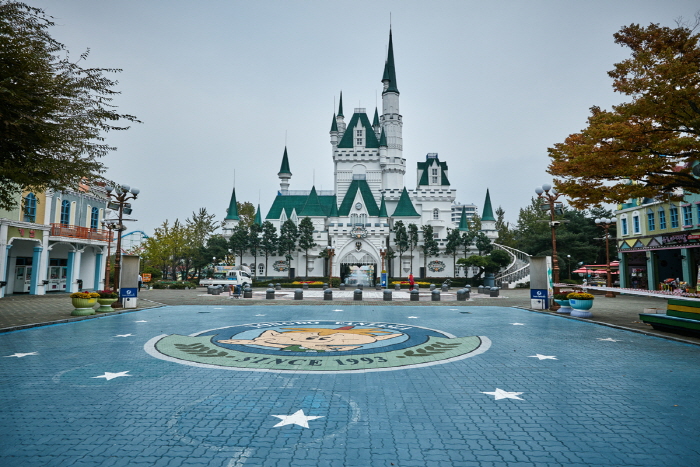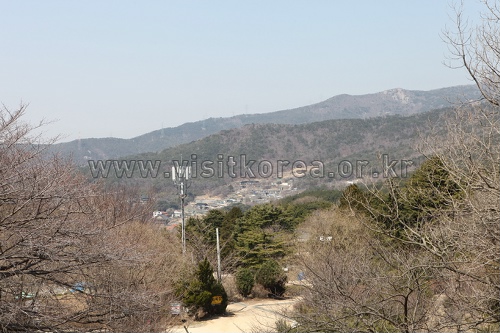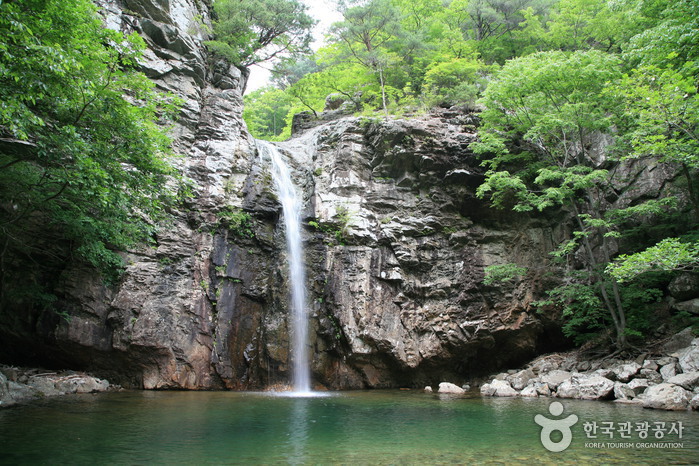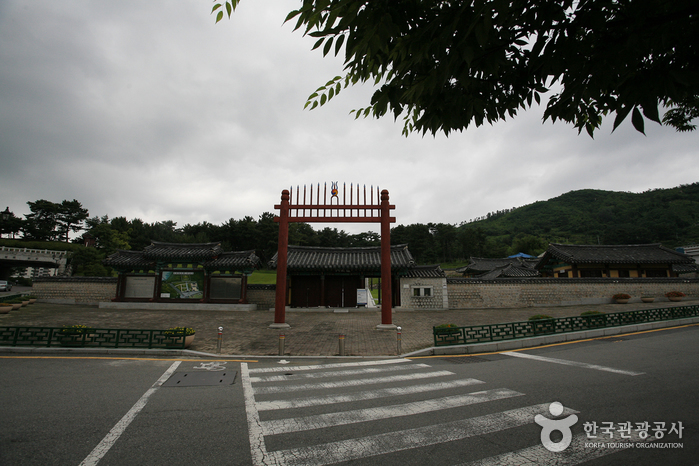Gimhae Astronomical Observatory (김해천문대)
16.8 Km 12405 2022-12-29
254, Gaya thema-gil, Gimhae-si, Gyeongsangnam-do
+82-55-337-3785
Gimhae Astronomical Observatory opened on February 1, 2002 as part of the Millennium Commemorative Project that started in December 1998. It was built to satisfy the general public’s curiosity about the universe and celestial bodies, inspire young people, and give everyone a unique, memorable experience. The observatory is shaped like an egg, in memory of the legend of King Kim Suro, the founder of the Garak Kingdom, according to which the king was born from an egg.
It is said that the queen of King Suro, Heo Hwang-ok, was a princess from the Indian country of Ayuta. Since sophisticated navigation equipment had yet to be invented, it can be assumed that she found her way to the Garak Kingdom by following the stars. It is also said that a prince of the Garak Kingdom built an observatory on the highest point of a mud fortress in Jinrye in order to make astronomical observations. The place is still referred to as Bibidan, which means a place to watch the stars.
These historical facts indicate the stars were very important to the Gaya, an ancient kingdom established mainly in the Gimhae area. The peak of Bunseongsan Mountain, where the observatory is located, offers sweeping views of the entire area of Gimhae. The night sky of Gimhae offers a breathtaking sight.
Tongdo Fantasia (통도환타지아)
17.2 Km 28424 2022-09-26
68, Tongdo 7-gil, Yangsan-si, Gyeongsangnam-do
+82-55-379-7000
Tongdo Fantasia is located in Yangsan, Gyeongsangnam-do, which shares borders with Milyang, Ulsan and Busan. This makes the amusement park very accessible by any means of transportation. Tongdo Fantasia operates Tongdo Country Club as well, and nearby Tongdosa Temple is also available for visitors who want to look around the local historic sites. The amusement park, the biggest theme park in Gyeongsangnam-do sits at the foot of Yeongchwisan Mountain, has over 30 amusement facilities, a large-scale swimming pool, a natural lake, a plaza for various events and a large-scale outdoor theatre, all offering various activities and events.
Olive Young - Inje Univ. Branch [Tax Refund Shop] (올리브영 인제대)
17.2 Km 0 2024-04-17
190, Inje-ro, Gimhae-si, Gyeongsangnam-do
-
Milyang189 (밀양189)
17.3 Km 0 2024-02-23
188-1 Yongpyeong-dong, Miryang-si, Gyeongsangnam-do
Milyang 189 is a spacious café situated near the Miryanggang River. Its interior, adorned with antique furniture and accessories, creates a charming European ambiance. The almond latte takes center stage as the signature menu item, complemented by other offerings such as einspänner and yeonyu latte (condensed milk latte). Visitors can relish the expertise of a professional barista, ensuring a delightful coffee experience with beans roasted to perfection.
Birthplace of the16th President of Korea, Roh Moo-hyun (진영 봉하마을과 노무현 대통령 생가)
17.3 Km 19028 2022-12-29
129, Bongha-ro, Gimhae-si, Gyeongsangnam-do
+82-1688-0523
Bongha Village is located 4.5km to the east of Jinyeong-eup, on the foot-slopes of Bonghwasan mountain. It is a typical farming village, and its major produce is Jinyeong sweet persimmons and rice. Its name comes from the mound above it on Bonghwasan mountain, where in the past beacons were lit as a method of communication. Bonghwasan mountain is home to Bonghwasa temple and two famous valleys: Doduk (thief) valley on the east side, named because of the many thieves that used to operate in the area, and Yasi (fox) valley on the west side, which looks like a fox lying on its front, looking back at its tail.
Birthplace of the former President of Korea, Roh Moo-hyun
The birthplace of the former President of Korea, Roh Moo-hyun, is a brick house with a slate roof that consists of two small rooms and a kitchen. Although it is a shabby house, everything in it seems rare and precious to visitors. The earth, stones, and water, as well as household items, are popular with visitors. Some visitors even take stones and soil from the garden home with them in plastic bags, and some take water, believing that water from the ex-president’s birthplace is almost sacred.
Bunsanseong Fortress (김해 분산성)
17.3 Km 25717 2023-01-18
210-162, Gaya-ro 405beon-gil, Gimhae-si, Gyeongsangnam-do
+82-55-330-3925
Bunsanseong Fortress was constructed in the 3rd year of the reign of Goryeo's King U (1377) by Magistrate Park Wi to defend against foreign enemies, but it was destroyed during the Japanese invasion of 1592. The fortress we see today was reconstructed by Magistrate Jeong Hyeon-seok in the 8th year of the reign of Joseon's King Gojong (1871). However, it is estimated that it was first built during the days of Gaya. It is a temoe-style fortress with rocks piled up like a long band at the peak of Bunsan from which downtown Gimhae, Gimhae Plains, the Nakdonggang River and the South Sea are all in a single, panoramic view. Today, fortress walls remain stretching for some 900 meters on the slope towards the city and, inside the fortress, there are two gate sites in the south and north, an auxiliary gate on the west, a well site and several other building sites. The exact length of the remaining fortress walls is 929 meters and the average x_width is about 8 meters.
Inside the fortress lies Haeeunsa Temple, which was built to pay respects to Queen Heo of Garak who had come from the sea, according to stories. The temple also enshrines portraits of King Suro and Queen Heo that were painted during the Joseon dynasty. During the Japanese invasion of 1592, monk soldiers were stationed at this temple.
The fortress is more popularly called "Manjangdae" by Gimhae locals, and this name originated from the description, "A tall tower 10,000 (man) gil in x_height," granted by Daewongun in the Joseon dynasty for this advanced base that defeats Japanese invaders. A writing of "Manjangdae" written by Daewongun himself as well as his stamp are engraved on a rock behind a beacon that was restored in 1999.
Beomeosa Temple (Busan) (범어사(부산))
17.4 Km 184683 2024-03-05
250 Beomeosa-ro, Geumjeong-gu, Busan
+82-51-508-3122
Beomeosa Temple, built in the Silla dynasty in 678, stands as a historic site known for producing outstanding monks. Situated amidst the splendid landscape of Geumjeongsan Mountain, it boasts a long tradition and rich history, housing numerous cultural relics. Visitors can experience the daily life of monk through templestay.
Geumjeongsan Mountain (Busan National Geopark) (금정산 (부산 국가지질공원))
17.8 Km 48179 2019-11-20
Geumseong-dong, Geumjeong-gu, Busan
+82-51-888-3636
Geumjeongsan Mountain was created by an overflow of magma approximately 70 million years ago. Over time, rain and wind shaped the mountain to what it is now, with gentle slopes and unique rock formations. The mountain features various walking trails and historical attractions, such as Beomeosa Temple and Geumjeongsanseong Fortress.
Paraesopokpo Falls (파래소폭포)
17.8 Km 24333 2021-06-16
200-78, Eoksaebeol-gil, Ulju-gun, Ulsan
+82-52-254-2123
Paraesopokpo Falls is located in Baenaegol Valley, connected to the foothills of Ganwolsan and Sinbulsan Mountains. The falls and surrounding valley are a popular attraction during the summer among vacationers and hikers eager to escape from the summer heat. The falls' water flows into Baenaecheon Stream, which later merges with the Nakdonggang River.
Tomb of Queen Consort of King Suro (김해 수로왕비릉)
18.0 Km 11580 2020-04-04
1, Garak-ro 190beon-gil, Gimhae-si, Gyeongsangnam-do
+82-55-338-1330
Tomb of Queen Consort of King Suro in Gusan-dong, Gimhae is the final resting place of Queen Heo, the Queen Consort of King Suro, the founder of Garak. The tomb dates all the way back to the Gaya dynasty and has been officially designated as Historic Site No. 74. Unlike many other ancient tomb mounds that are raised on flat land, Queen Heo's mound sits high upon a hill. In front of the tomb is Pasa Stone Pagoda, which its stones are known to have come from India.
Together with the Tomb of King Suro, the tomb preservation area was expanded in the 28th year of King Sejong’s reign (1446). Records indicate that the tombs were robbed over a century later during the Imjin War (1592-1598). The current headstone and plaque by the tomb was installed in the Joseon dynasty in the 25th year of King Injo's reign (1641).





 English
English
 한국어
한국어 日本語
日本語 中文(简体)
中文(简体) Deutsch
Deutsch Français
Français Español
Español Русский
Русский